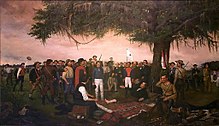Battle of San Jacinto
After being held for about three weeks as a prisoner of war, Santa Anna signed the peace treaty that dictated that the Mexican army leave the region, paving the way for the Republic of Texas to become an independent country.
General Antonio López de Santa Anna was a proponent of governmental federalism when he helped oust Mexican President Anastasio Bustamante in December 1832.
Upon his election as president in April 1833,[4] Santa Anna switched his political ideology and began implementing centralist policies that increased the authoritarian powers of his office.
[6][7] Colonel Juan Almonte was appointed director of colonization in Texas,[8] ostensibly to ease relations with the colonists and mitigate their anxieties about Austin's imprisonment.
Behind the rhetoric, his covert mission was to identify the local power brokers, obstruct any plans for rebellion, and supply the Mexican government with data that would be of use in a military conflict.
For nine months in 1834, under the guise of serving as a government liaison, Almonte traveled through Texas and compiled an all-encompassing intelligence report on the population and its environs, including an assessment of their resources and defense capabilities.
[10] In consolidating his power base, Santa Anna installed General Martín Perfecto de Cos as the governing military authority over Texas in 1835.
[19] Santa Anna and his aide-de-camp Almonte[20] forded the Rio Grande at Guerrero, Coahuila on February 16, 1836,[21] with General José de Urrea and 500 more troops following the next day at Matamoros.
William B. Travis, the garrison commander, sent Albert Martin to request a meeting with Almonte, who replied that he did not have the authority to speak for Santa Anna.
[23] Colonel James Bowie dispatched Green B. Jameson with a letter, translated into Spanish by Juan Seguín, requesting a meeting with Santa Anna, who immediately refused.
[25] Urrea proceeded to secure the Gulf Coast and was victorious in two skirmishes with Texian detachments serving under Colonel James Fannin at Goliad.
[30][31] When news of the declaration reached Goliad, Benavides informed Fannin that in spite of his opposition to Santa Anna, he was still loyal to Mexico and did not wish to help Texas break away.
[34] Survivors Susanna Dickinson, her daughter Angelina, Travis' slave Joe, and Almonte's cook Ben were spared by Santa Anna and sent to Gonzales, where Texian volunteers had been assembling.
[35] The same day that Mexican troops departed Béxar, Houston arrived in Gonzales and informed the 374 volunteers (some without weapons) gathered there that Texas was now an independent republic.
A cavalry company led by Seguín and Salvador Flores were assigned as rear guard to evacuate the more isolated ranches and protect the civilians from attacks by Mexican troops or Indians.
[45] Interim Secretary of War Thomas Rusk joined the camp, with orders from President David G. Burnet to replace Houston if he refused to fight.
After receiving word that acting President Miguel Barragán had died, Santa Anna seriously considered returning to Mexico City to solidify his position.
Fear that Urrea's victories would position him as a political rival convinced Santa Anna to remain in Texas to personally oversee the final phase of the campaign.
[51][52] Government officials fled mere hours before Mexican troops arrived in Harrisburgh (now Harrisburg, Houston) and Santa Anna sent Almonte with 50 cavalry to intercept them in New Washington.
After loud protests from Seguín and Antonio Menchaca, the order was rescinded, provided the Tejanos wear playing cards in their hats to identify them as Texian soldiers.
[58][59] Over the protests of several of his officers, Santa Anna chose to make camp in a vulnerable location, a plain near the San Jacinto River, bordered by woods on one side, marsh and lake on another.
[69] Not long after Cos arrived with reinforcements, General Houston ordered Smith to destroy Vince's Bridge (located about 8 miles from the Texian encampment) to block the only road out of the Brazos and, thereby, prevent any possibility of escape by Santa Anna.
[80] Texians had won the battle because of mistakes made by Santa Anna, and Houston was well aware that his troops would have little hope of repeating their victory against Urrea or Filisola.
[84] In a letter to Filisola, who was now the senior Mexican official in Texas, Santa Anna wrote that "yesterday evening [we] had an unfortunate encounter" and ordered his troops to retreat to Béxar and await further instructions.
[87] When Mexican authorities received word of Santa Anna's defeat at San Jacinto, flags across the country were lowered to half staff and draped in mourning.
Houston and Santa Anna both refused to order their soldiers to bury the dead so they lay on the property of Margaret "Peggy" McCormick who owned the land where the battle took place.
[94] For years, Mexican authorities used the reconquering of Texas as an excuse for implementing new taxes and making the army the budgetary priority of the impoverished nation.
[103] Larger expeditions were postponed as military funding was consistently diverted to other rebellions, out of fear that those regions would ally with Texas and further fragment the country.
[109] Voters overwhelmingly chose Houston the first president, ratified the constitution drawn up by the Convention of 1836, and approved a resolution to request annexation to the United States.
When the veteran battleship USS Texas was decommissioned in 1948 and made into a museum ship, it was decided to give her a permanent anchorage near the San Jacinto Monument.






